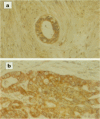Abstract
Expression of insulin-like growth factor-I (IGF-I), its receptor and IGF-binding proteins (IGFBPs) by ovarian cancer cells and its mitogenic effect on these cells in vitro, suggest that IGF-I may have a role in regulation of human ovarian cancer. We have recently shown IGFBP-2 to be markedly elevated in malignant ovarian cyst fluid in vivo. To identify the origin of increased IGFBP-2 in these cyst fluids, the gene expression and protein content of IGFBP-2 were investigated in 14 malignant and four benign epithelial ovarian neoplasms. IGFBP-2 mRNA was detected in all ovarian specimens and was 2- to 30-fold higher in malignant than in benign neoplasms. Within the malignant tissues IGFBP-2 mRNA levels correlated with the aggressiveness of the tumour and were higher in invasive tumours than in those with borderline pathology. Southern blot analysis revealed no amplification of IGFBP-2 gene in the DNA samples from ovarian tumours regardless of their nature. IGFBP-2 was the major binding protein in tissue extracts, as measured by both Western ligand blotting and immunoblotting, and was significantly higher in malignant than in benign neoplasms. These findings were further supported by immunohistochemical detection of IGFBP-2 in tumour sections. Our data suggest that increased local production by the tumour in vivo is responsible for the increased IGFBP-2 levels in the cyst fluid bathing the ovarian malignancy. This may represent an autocrine regulatory mechanism for IGF-I proliferative effect of ovarian cancer.
Full text
PDF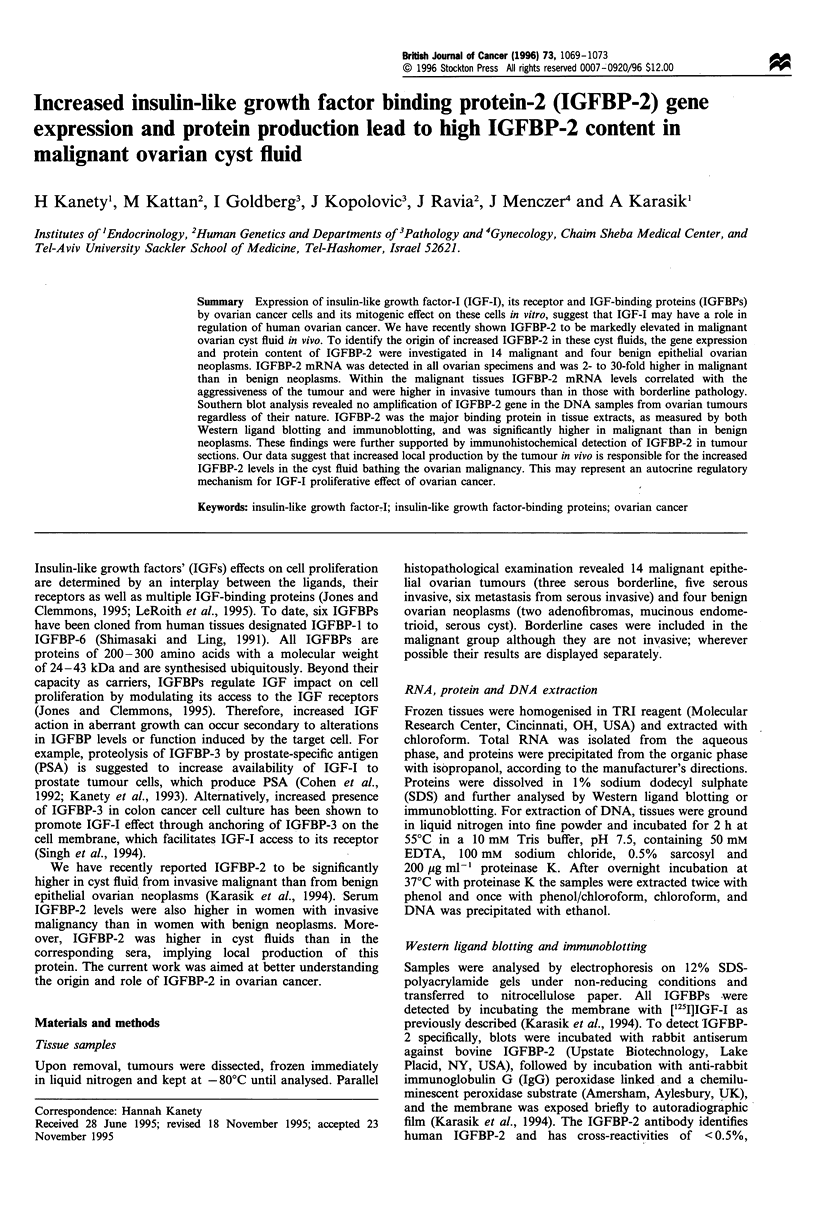

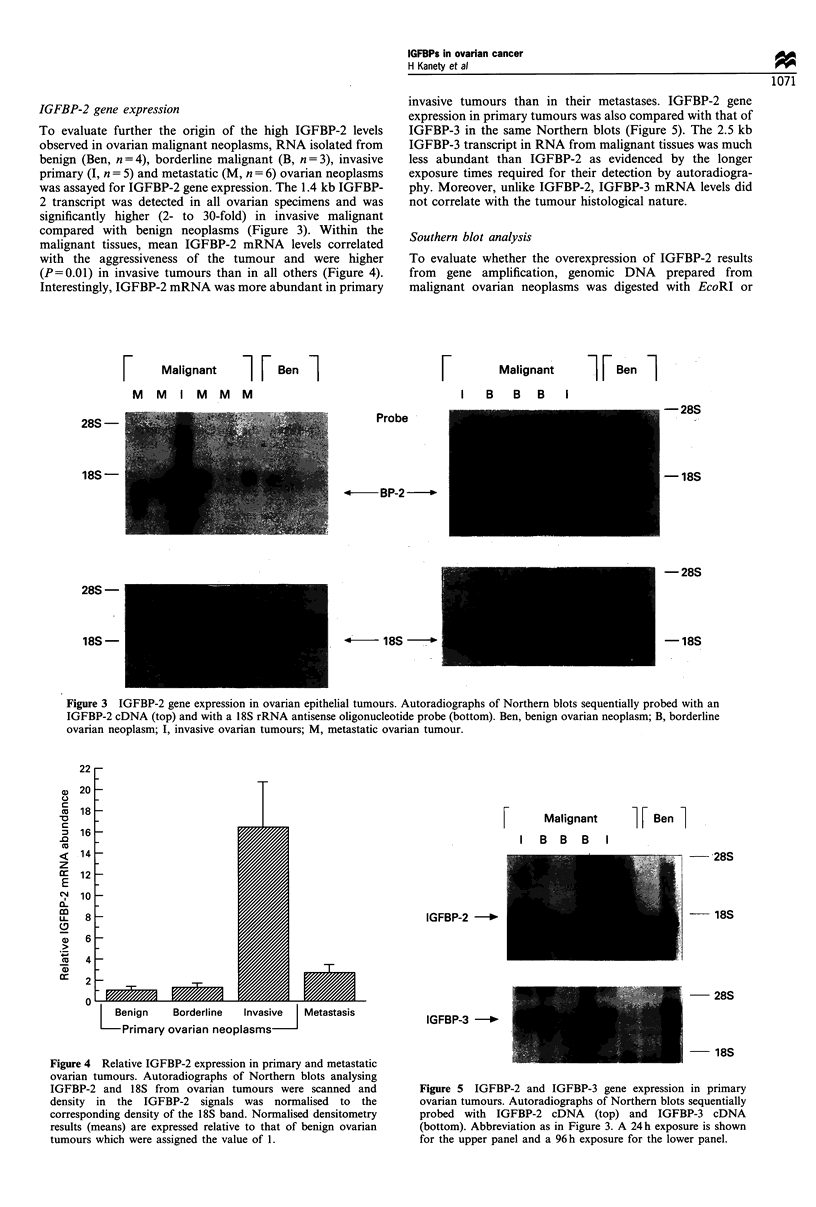
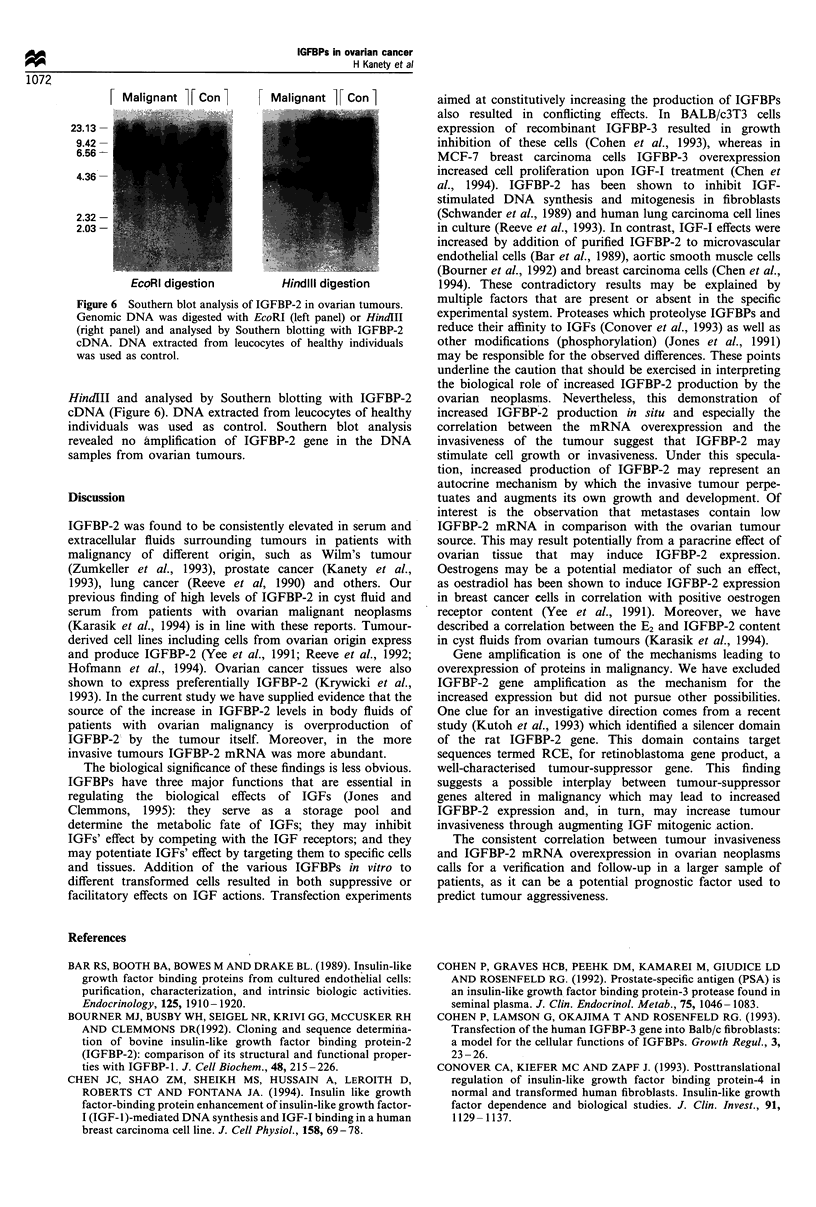
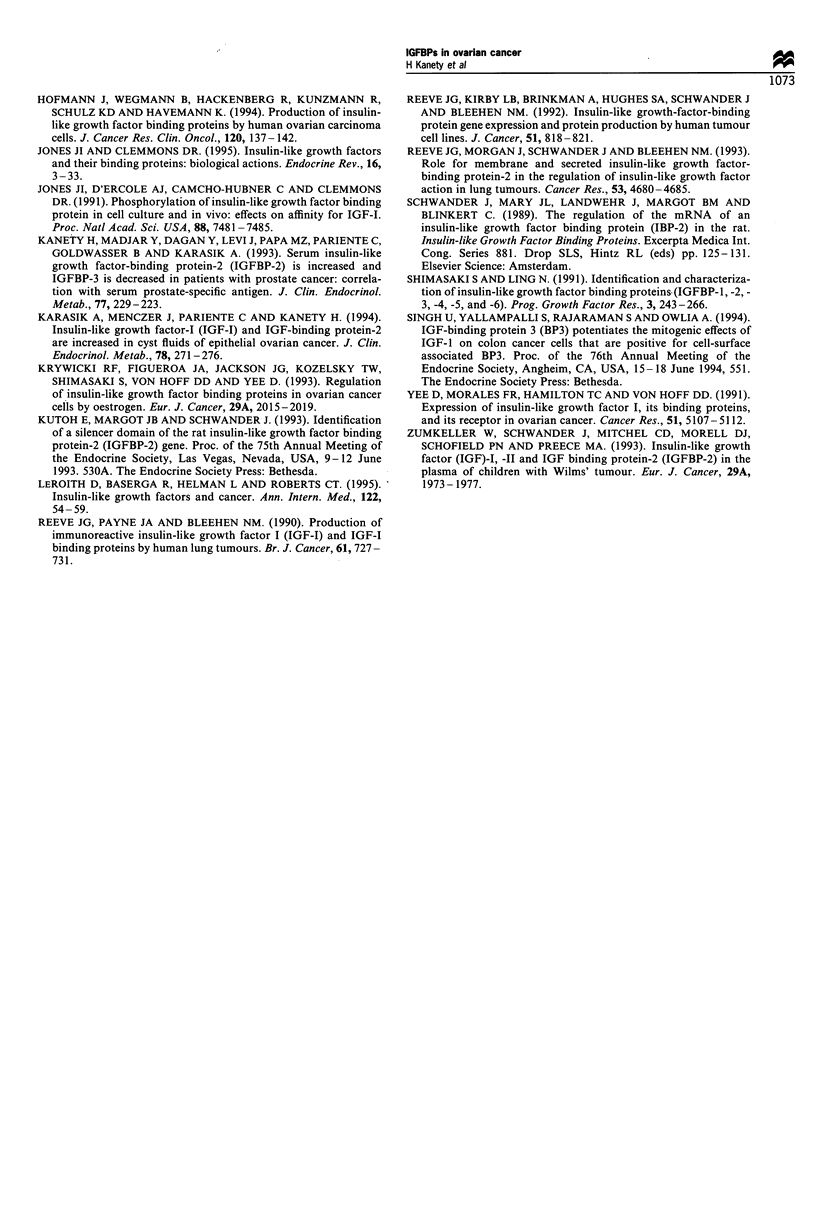
Images in this article
Selected References
These references are in PubMed. This may not be the complete list of references from this article.
- Bar R. S., Booth B. A., Boes M., Dake B. L. Insulin-like growth factor-binding proteins from vascular endothelial cells: purification, characterization, and intrinsic biological activities. Endocrinology. 1989 Oct;125(4):1910–1920. doi: 10.1210/endo-125-4-1910. [DOI] [PubMed] [Google Scholar]
- Bourner M. J., Busby W. H., Jr, Siegel N. R., Krivi G. G., McCusker R. H., Clemmons D. R. Cloning and sequence determination of bovine insulin-like growth factor binding protein-2 (IGFBP-2): comparison of its structural and functional properties with IGFBP-1. J Cell Biochem. 1992 Feb;48(2):215–226. doi: 10.1002/jcb.240480212. [DOI] [PubMed] [Google Scholar]
- Chen J. C., Shao Z. M., Sheikh M. S., Hussain A., LeRoith D., Roberts C. T., Jr, Fontana J. A. Insulin-like growth factor-binding protein enhancement of insulin-like growth factor-I (IGF-I)-mediated DNA synthesis and IGF-I binding in a human breast carcinoma cell line. J Cell Physiol. 1994 Jan;158(1):69–78. doi: 10.1002/jcp.1041580110. [DOI] [PubMed] [Google Scholar]
- Cohen P., Graves H. C., Peehl D. M., Kamarei M., Giudice L. C., Rosenfeld R. G. Prostate-specific antigen (PSA) is an insulin-like growth factor binding protein-3 protease found in seminal plasma. J Clin Endocrinol Metab. 1992 Oct;75(4):1046–1053. doi: 10.1210/jcem.75.4.1383255. [DOI] [PubMed] [Google Scholar]
- Cohen P., Lamson G., Okajima T., Rosenfeld R. G. Transfection of the human IGFBP-3 gene into Balb/c fibroblasts: a model for the cellular functions of IGFBPs. Growth Regul. 1993 Mar;3(1):23–26. [PubMed] [Google Scholar]
- Conover C. A., Kiefer M. C., Zapf J. Posttranslational regulation of insulin-like growth factor binding protein-4 in normal and transformed human fibroblasts. Insulin-like growth factor dependence and biological studies. J Clin Invest. 1993 Mar;91(3):1129–1137. doi: 10.1172/JCI116272. [DOI] [PMC free article] [PubMed] [Google Scholar]
- Hofmann J., Wegmann B., Hackenberg R., Kunzmann R., Schulz K. D., Havemann K. Production of insulin-like growth factor binding proteins by human ovarian carcinoma cells. J Cancer Res Clin Oncol. 1994;120(3):137–142. doi: 10.1007/BF01202191. [DOI] [PubMed] [Google Scholar]
- Jones J. I., D'Ercole A. J., Camacho-Hubner C., Clemmons D. R. Phosphorylation of insulin-like growth factor (IGF)-binding protein 1 in cell culture and in vivo: effects on affinity for IGF-I. Proc Natl Acad Sci U S A. 1991 Sep 1;88(17):7481–7485. doi: 10.1073/pnas.88.17.7481. [DOI] [PMC free article] [PubMed] [Google Scholar]
- Kanety H., Madjar Y., Dagan Y., Levi J., Papa M. Z., Pariente C., Goldwasser B., Karasik A. Serum insulin-like growth factor-binding protein-2 (IGFBP-2) is increased and IGFBP-3 is decreased in patients with prostate cancer: correlation with serum prostate-specific antigen. J Clin Endocrinol Metab. 1993 Jul;77(1):229–233. doi: 10.1210/jcem.77.1.7686915. [DOI] [PubMed] [Google Scholar]
- Karasik A., Menczer J., Pariente C., Kanety H. Insulin-like growth factor-I (IGF-I) and IGF-binding protein-2 are increased in cyst fluids of epithelial ovarian cancer. J Clin Endocrinol Metab. 1994 Feb;78(2):271–276. doi: 10.1210/jcem.78.2.7508947. [DOI] [PubMed] [Google Scholar]
- Krywicki R. F., Figueroa J. A., Jackson J. G., Kozelsky T. W., Shimasaki S., Von Hoff D. D., Yee D. Regulation of insulin-like growth factor binding proteins in ovarian cancer cells by oestrogen. Eur J Cancer. 1993;29A(14):2015–2019. doi: 10.1016/0959-8049(93)90464-q. [DOI] [PubMed] [Google Scholar]
- LeRoith D., Baserga R., Helman L., Roberts C. T., Jr Insulin-like growth factors and cancer. Ann Intern Med. 1995 Jan 1;122(1):54–59. doi: 10.7326/0003-4819-122-1-199501010-00009. [DOI] [PubMed] [Google Scholar]
- Morgan P. P., Sherrington A. Where have all the editorialists gone? Can Med Assoc J. 1981 Jul 15;125(2):131–131. [PMC free article] [PubMed] [Google Scholar]
- Reeve J. G., Kirby L. B., Brinkman A., Hughes S. A., Schwander J., Bleehen N. M. Insulin-like growth-factor-binding protein gene expression and protein production by human tumour cell lines. Int J Cancer. 1992 Jul 9;51(5):818–821. doi: 10.1002/ijc.2910510525. [DOI] [PubMed] [Google Scholar]
- Reeve J. G., Morgan J., Schwander J., Bleehen N. M. Role for membrane and secreted insulin-like growth factor-binding protein-2 in the regulation of insulin-like growth factor action in lung tumors. Cancer Res. 1993 Oct 1;53(19):4680–4685. [PubMed] [Google Scholar]
- Reeve J. G., Payne J. A., Bleehen N. M. Production of immunoreactive insulin-like growth factor-I (IGF-I) and IGF-I binding proteins by human lung tumours. Br J Cancer. 1990 May;61(5):727–731. doi: 10.1038/bjc.1990.163. [DOI] [PMC free article] [PubMed] [Google Scholar]
- Shimasaki S., Ling N. Identification and molecular characterization of insulin-like growth factor binding proteins (IGFBP-1, -2, -3, -4, -5 and -6). Prog Growth Factor Res. 1991;3(4):243–266. doi: 10.1016/0955-2235(91)90003-m. [DOI] [PubMed] [Google Scholar]
- Yee D., Morales F. R., Hamilton T. C., Von Hoff D. D. Expression of insulin-like growth factor I, its binding proteins, and its receptor in ovarian cancer. Cancer Res. 1991 Oct 1;51(19):5107–5112. [PubMed] [Google Scholar]
- Zumkeller W., Schwander J., Mitchell C. D., Morrell D. J., Schofield P. N., Preece M. A. Insulin-like growth factor (IGF)-I, -II and IGF binding protein-2 (IGFBP-2) in the plasma of children with Wilms' tumour. Eur J Cancer. 1993;29A(14):1973–1977. doi: 10.1016/0959-8049(93)90455-o. [DOI] [PubMed] [Google Scholar]



